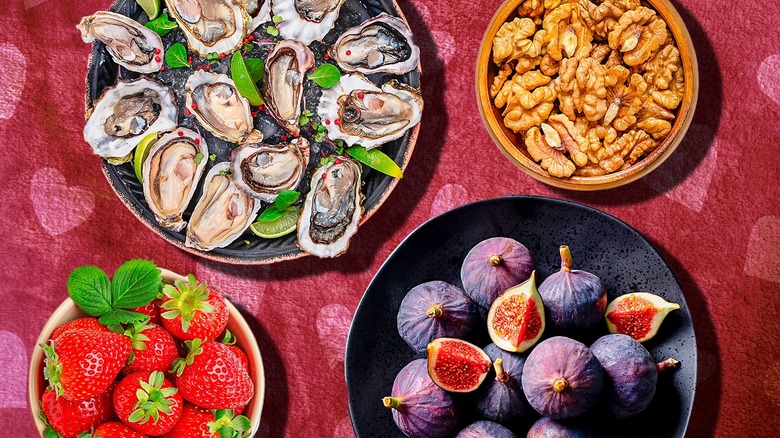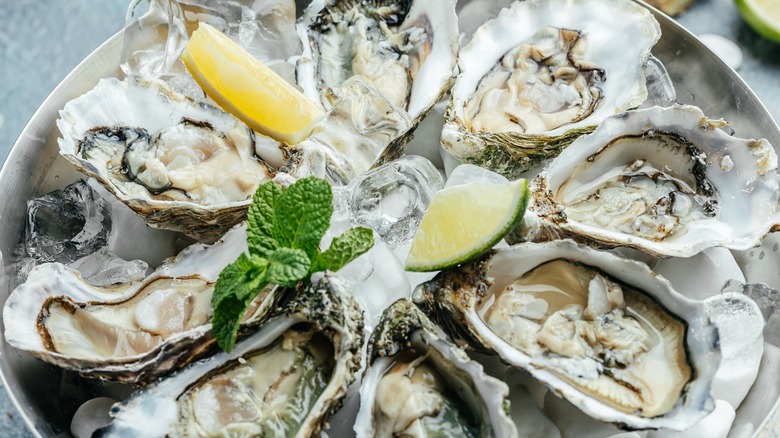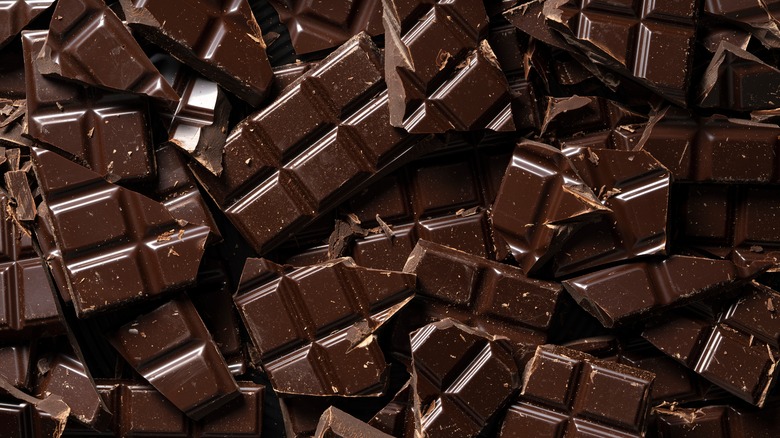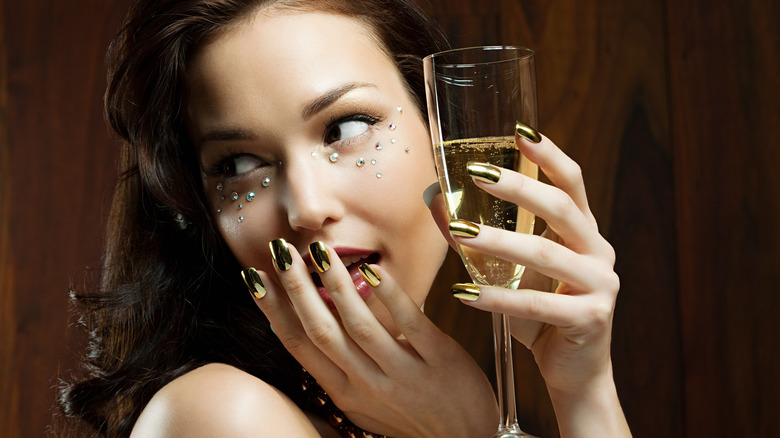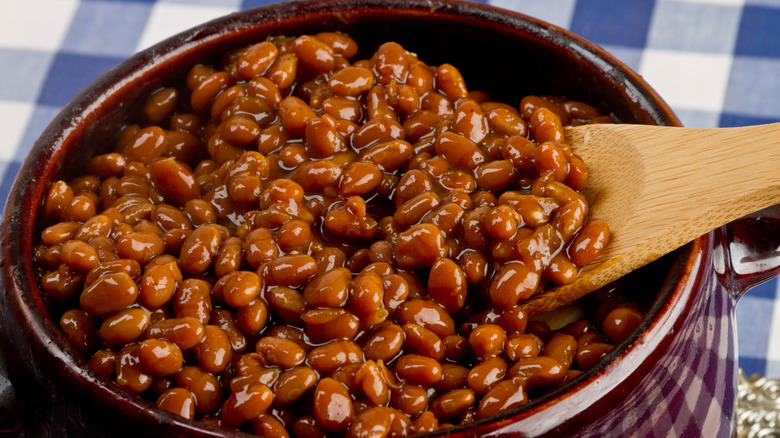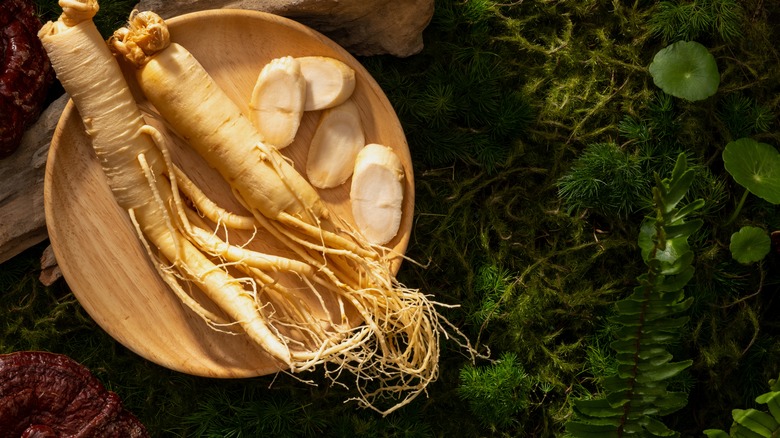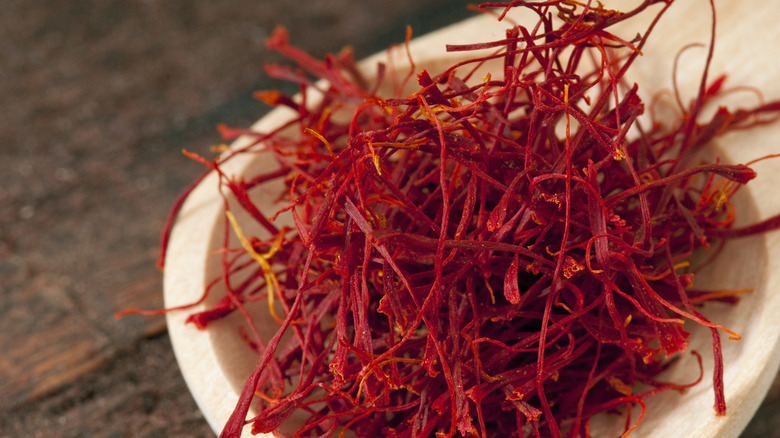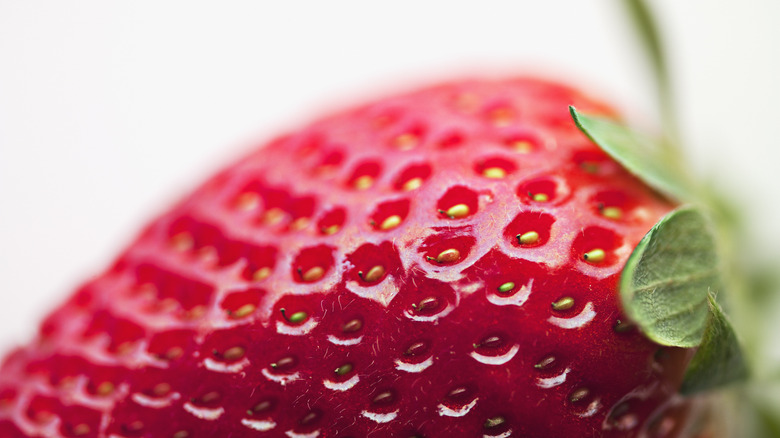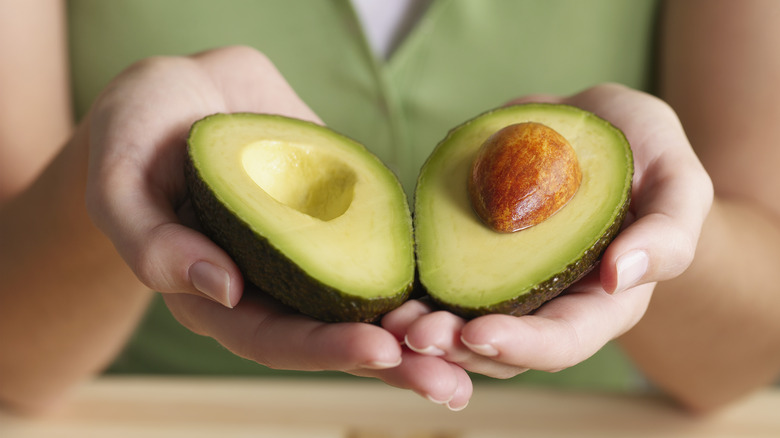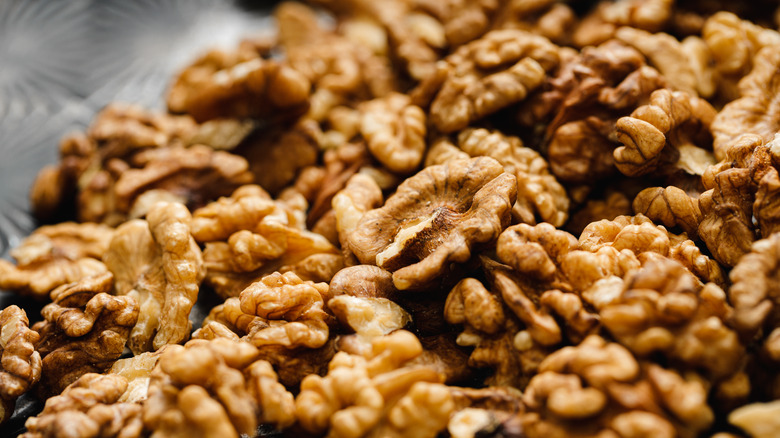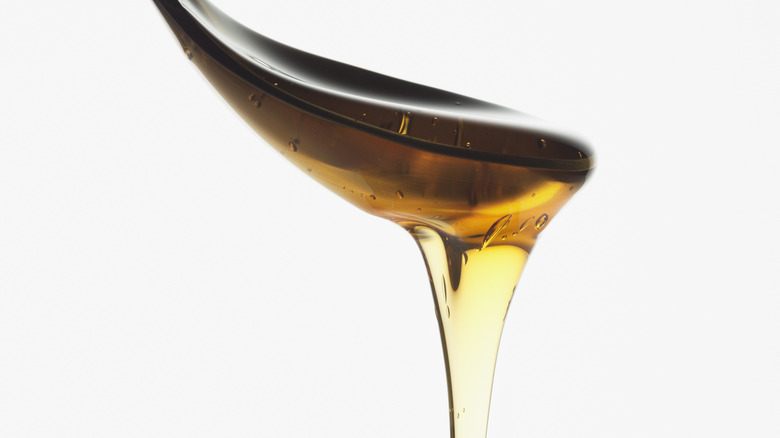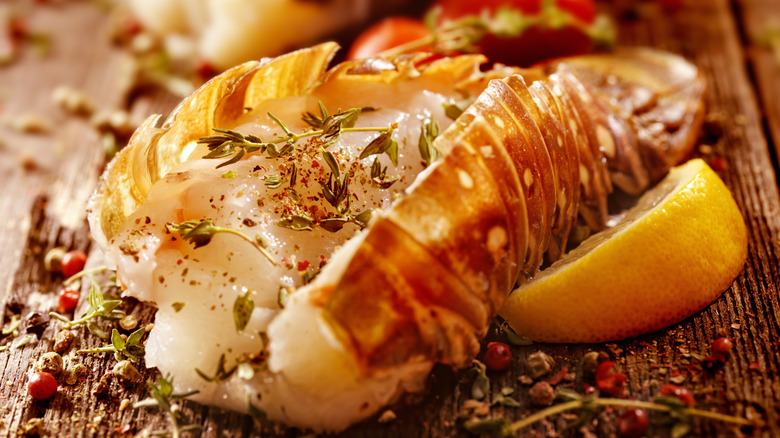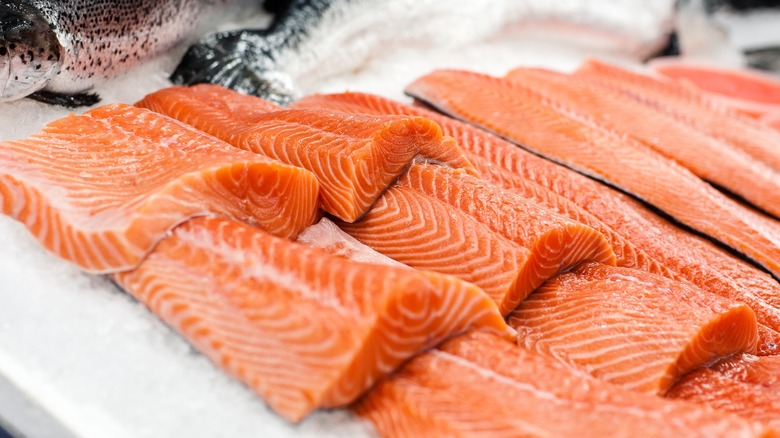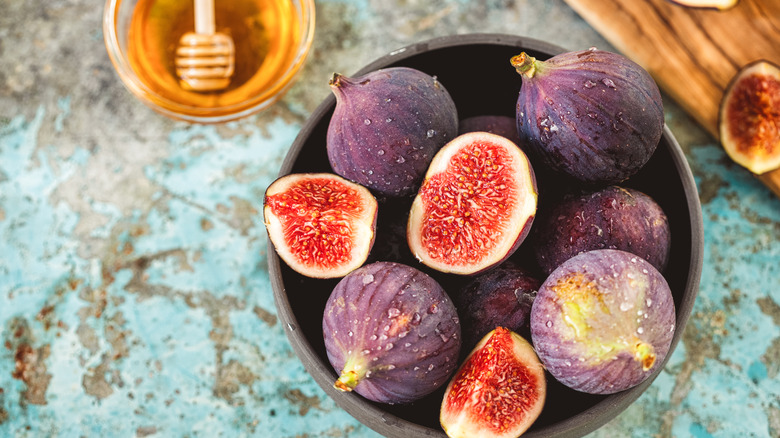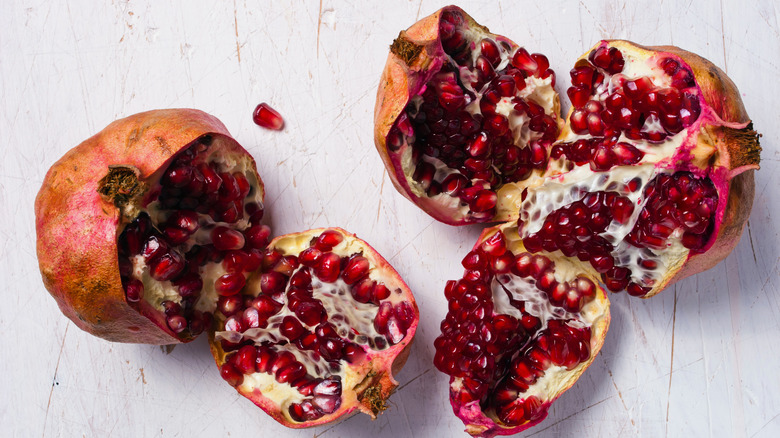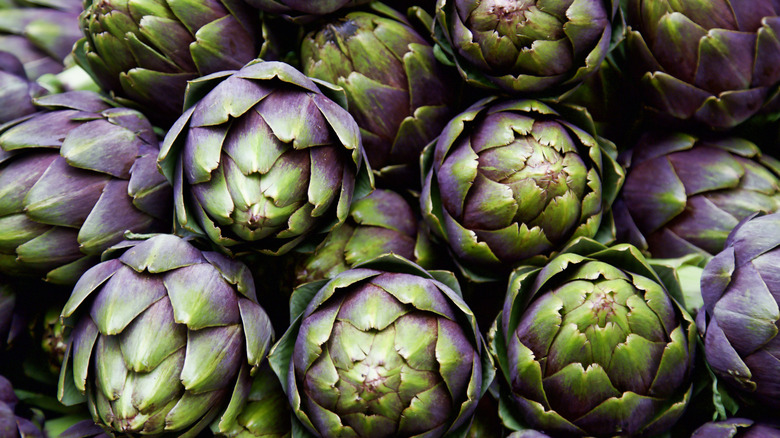15 Edible Aphrodisiacs To Enjoy This Valentine's Day
You know what they say about Valentine's Day — it's the time when love is in the air. But love isn't just in the air, it's also on your plate. There are many foods and herbs that are aphrodisiacs — meaning that they supposedly boost sexual desire or sexual performance. These foods have been around for centuries and have appeared everywhere, from mythology (the word "aphrodisiac" itself is derived from the Greek goddess of love, Aphrodite) to pop culture. However, science is still in its infancy of determining if some of these foods actually have an impact on bedroom activities or if the stories are purely anecdotal — or just plain placebo.
Regardless, we're here to highlight some of the most popular foods often thought to have aphrodisiac qualities. And even if the foods aren't true aphrodisiacs (after all, you'd probably have to eat a lot of dark chocolate to feel much of anything besides full), your tastebuds will still be satisfied.
Oysters
Nothing wakes up our senses like the fishy, briny odor exuded from a plate of oysters over ice. This mollusk has long been associated with sex, but the exact science behind how this seafood boosts our libido is as murky as the waters it lives in. Oysters are considered an aphrodisiac because they're full of nutrients that help support sexual health, like omega-3s. This critical fatty acid is important in increasing blood flow to all body parts — and by that, we mean all parts. Outside of its use as a sort of natural Viagra, regularly eating omega-3s can is also linked to improved cardiovascular function and reduced inflammation.
Another reason why the oyster is often associated with sexual health is due to its high levels of zinc, a mineral that contributes to reproductive fertility and the regulation of hormones like testosterone. Another nutrient in these humble mollusks also supports testosterone called D-aspartic acid.
There are many ways to enjoy oysters, including ritzy oysters Rockefeller or in a fancy stew. But, for the well-being of your special someone, be sure to give your teeth a good brushing afterward.
Dark chocolate
There has to be a reason why chocolate companies make a fortune on Valentine's Day — right? Besides the attractive, heart-shaped boxes and colorful arrangements of reds, pinks, and whites lies a pretty potent concoction of compounds. Your favorite dark chocolate bar likely contains phenylethylamine, antioxidants, and caffeine, notes the National Library of Medicine, all of which stimulate your nervous system and get you feeling in the mood. It will also contribute to releasing the happiness hormone, serotonin, which has reverberating impacts on the rest of your body and overall mood. Besides these chemicals, there's just something so pleasurable about feeling your favorite dark chocolate bar melt on the tip of your tongue.
Besides its chemical benefits, dark chocolate has long been touted as an aphrodisiac because of its history. The early Aztec and Mayan civilizations presented proto-hot chocolate at fertility ceremonies and weddings because they believed in its romantic and passion-inducing qualities. Over the years, chocolate has been a symbol of love and affection given to others for special occasions and events like Valentine's Day.
Champagne
Champagne has a significantly shorter aphrodisiac timeline than other foods, considering it wasn't actually developed until the 19th century. Its interlinking with opulence and royalty gives the bottle its high social clout and endows it with more romantic qualities than other alcoholic beverages. We also associate the beverage with highly sexualized films like James Bond, which gives this beverage a sultry impression. And not to mention, there's something deeply romantic about uncorking it, twisting off the cap with a pop, and watching the froth gush out and down the bottle like a coursing, foamy river.
Scientifically speaking, the beverage's aphrodisiac qualities are often also linked to the tingly sensation it has on the tongue, as well as its relatively quick absorption time to the brain. Others link its yeasty flavor to the female body, whereas its concentration of zinc, potassium, and magnesium are linked to reproduction and female sexual health.
Baked beans
Although flatulence is not often seen as the most romantic flattering thing, it is a side effect of enjoying a crock of beans. But, contrary to popular belief, baked beans may make you feel more romantic because they are packed with zinc. This mineral regulates many elements of sexual health, particularly for men, including boosting testosterone, sperm count, and libido. Zinc also plays a major role in the regulation of prolactin — which, combined with testosterone, is given as a supplement to support sexual health and regulate complications like erectile dysfunction and premature ejaculation.
Despite its positive health benefits, beans tend not to the sexiest of the aphrodisiac foods. You can certainly make them a bit more palatable by adding in a pour of bourbon and saving a swig for yourself, or combining it with another aphrodisiac like honey. Regardless, it's one marketing campaign that we probably won't expect to see on a can of Bush's anytime soon.
Ginseng
Ginseng is an innocuous addition to energy drinks and teas, but its connection to health and sexual well-being has long been noted. In traditional Chinese medicine, adds the National Library of Medicine, ginseng was historically used to treat erectile dysfunction and boost libido. The likely cause of this effect is linked to ginsenosides — which, besides sexual health, are recognized to optimize physical performance and potentially even slow aging. However, not all types of ginseng give this effect; American ginseng and Asian ginseng both contain ginsenosides, while Siberian ginseng does not.
Research has suggested that although these chemicals do not directly interfere with altering the hormones in the body, they can still be linked to decreasing the instances of erectile dysfunction, notes the News Medical Life Science. It's also important to note that many of the studies associated with ginseng have not highlighted the long-term effects of the supplement, nor have had large enough sample sizes to iron out the details about how ginsenosides impact sexual health and wellbeing. For the most part, though, it's safe to say that a single can of Arizona iced tea won't send your body into a sexual frenzy.
Saffron
If you know one thing about saffron, it's probably that it's not cheap. It's the world's most expensive spice, clocking in at nearly $10,000 per pound wholesale. But did you know that it's also one of the world's most potent aphrodisiacs? Saffron has been used for its medicinal qualities for a very long time. The ancient Minoans used it as a contraceptive to reduce the symptoms of premenstrual syndrome as far back as 1650 B.C.E. It's also important to note that the symbolism of this spice is important too, for both its dark red color and sourcing from the stigma — female sex organ of the plant.
There has also been promising research recently, adds Healthline, about the treatment of antidepressant-related erectile dysfunction in men, as well as boosting both libido and overall sexual satisfaction. However, no research has shown that the spice can help improve sperm count or mobility. Besides these uses, saffron is also a subtle spice that will add flavor and color to your paella — provided that you can get your hands on it.
Strawberries
Each gushing bite into a strawberry is bound to cover your hands and lips in a sticky red film. Besides the sultry experience of eating these fruits, there is also a pop culture phenomenon surrounding why we're obsessed with the sexy strawberry, like the scene from "Pretty Woman" starring Julia Roberts.
We can thank the Romans for the initial connection between these berries and love. Strawberries are associated with Valentine's Day because they are a symbol of the goddess Venus, who herself is a symbol of love and beauty. Churches eventually began incorporating the fruit into altars and pillars to encapsulate its beauty. Moreover, the seeds were often symbols of fertility, with some legends noting that if two individuals enjoyed one fruit together, they would surely fall in love. Chemically, there are some benefits to the strawberry, including antioxidants and vitamin C, which aid in pumping blood throughout the body.
There are many romantic ways to prepare the strawberry. But the most popular is probably the chocolate-covered fruit, which you can DIY or purchase just in time for Valentine's Day.
Avocado
The ancient Aztecs referred to the avocado tree as ahuacuatl, which roughly translates to "testicle tree." History buffs note that the name was likely due to observations that the fruit hangs low on the tree and in pairs. But it's not just the appearance of the tree that triggers dirty thoughts. Its suggestive fruits are packed with vitamins and minerals, including potassium, vitamin E, beta-carotene, and magnesium, notes Healthline, which help promote healthy blood flow and sexual function. In addition, the fruit is an excellent source of folate, which may be why it may associated with fertility.
In the 1920s, an American advertising campaign for the fruit attempted to deny the aphrodisiac qualities of the fruit, thinking that revealing these qualities would discourage consumers from purchasing the fruit. However, the reverse of this occurred and helped popularize the avocado in American markets. And honestly, we think that's worth making a bowl of guacamole over.
Walnuts
The inside of a walnut bears some likeness to the female reproductive system, but there are also numerous chemical qualities that give the walnut its reputation as an aphrodisiac. According to research published in the journal Nutrients, men who added a ½ cup of nuts (in this case, a mixture of walnuts, almonds, and others) to their diets every day during the 14-week study period reported an increase in sexual desire and function, but there is limited understanding as to the mechanisms for why this occurs. However, it's likely that the presence of omega-3 fatty acids plays some role in this, as well as other beneficial compounds like polyphenols and vitamin E. Other research has shown, like in Current Developments in Nutrition, that the regular consumption of walnuts can increase sperm mobility.
Walnuts have long been associated with fertility. The Greeks, for example, believed that the walnut tree's prolific development of the nuts would signify its health. The culture carried over the tradition of throwing walnuts at the bride and groom on their wedding day to signify a healthy future pregnancy for the couple.
Honey
The symbolic connection between honey and human sexuality is vast and dates back centuries. Hippocrates, a Greek philosopher, once prescribed honey to increase sexual vigor, while other physicians recommended combining it with ginger and pepper to cure erectile dysfunction. Mythologists also connected the powerful sweetener to mythology, where it was described as Aphrodite's "nectar."
There are some notable compounds in honey that lend truth to its reputation as an aphrodisiac. Honey is a source of boron, which helps regulate the body's estrogen and testosterone, among other bodily functions. It also contains chrysin, which is said to boost testosterone in the short term. Men might also get some specific benefits from introducing more honey into their diet; it boosts nitric oxide levels in the blood, notes a study in Integrative Medicine: A Clinician's Journal, which helps contribute to improved blood flow during sexual arousal. However, it should be noted that researchers are not conclusive about honey's overall aphrodisiac effects, adds a study in the Pharmacognosy Review, so if you're not the biggest fan of honey, perhaps opt for another food on this list.
Honey doesn't just have to be a sweet addition to your love life. You can also spice things up with hot honey — which is especially delicious when drizzled onto pizza or toast.
Lobster
The lobster has been considered an aphrodisiac across many cultures, including the Greeks and Belizeans, but it wasn't revered as one in American pop culture until comparatively recently. In fact, lobster was once served to American prisoners because of its massive population, as well as a limited admiration for the culinary potential of the ingredient. After more restaurants started cooking with the lobster and elevating its status among wealthy socialites, the lobster emerged as a symbol of wealth, opulence, and, by proxy, sex.
Salvador Dali even went as far as to construct the Lobster Telephone, a Surrealist-style sculpture featuring cooked lobster sitting atop a dial phone base to cover its underbelly and sex organs. He also created a similar living sculpture with a live lobster sitting on a red telephone, which bore the more suggestive name of the "Aphrodisiac Telephone." In his later years, Dali used the lobster as a symbol of feminity, including in the creation of a ball gown that featured a lobster tail covering the model's lower body.
Besides these artistic references, there is little clear science about what chemical component of the lobster triggers a sexual response. Some note that it is a lean source of protein (which is great for fueling all sorts of activities), as well as vitamin B-12, which aids in hormone regulation, notes Healthline.
Salmon
If sushi or a fancy fish dinner is on your Valentine's Day dinner menu this year, consider yourself lucky. Not only will you get a delicious piece of fish (which should really be enough draw on its own), but you'll also get a healthy boost of vitamins, protein, and minerals to power your other holiday plans. Like other aphrodisiacs, salmon is a rich source of omega-3 fatty acids, adds Healthline, which can boost libido via hormone regulation. Besides the science, there's also been a romantic association with the pink color of the salmon's flesh and the popular holiday.
It's not just the body of the salmon that's beneficial for romantic activities. Its roe (eggs) are also rich in protein and zinc, which are particularly helpful in boosting sperm count and libido. The caviar harvested from other fish, like the popular sturgeon, is also rich in L-arginine, comments Imperia Caviar, an amino acid that helps boost blood flow.
Figs
Figs are one of the most beautiful fruits to look at, so it's no surprise that the fruit has become associated with feminity. But there's more than meets the eye when it comes to its soft, red flesh. Figs contain high amounts of beta-carotene, a precursor to vitamin A, notes a study in the journal Nutrients, which has been known to increase libido, regulate hormones like estrogen, and increase the feeling of desire during sex.
Although these fruits might be relatively uncommon in recipes or hard to find at the grocery store, they're worth looking out for. You can prepare a special fig upside-down cake with bay leaf caramel to wrap up your romantic dinner for two or stick to a light appetizer with our salami and fig flatbread. And when all else fails, you can eat figs straight from the package yourself or feed them to your special someone. Just don't forget the napkin — things might get a little juicy.
Pomegranate
Pomegranates are fruits that just ooze sex. Mythology claims that Aphrodite herself was the first to plant a pomegranate tree, thus giving the fruit strong linkages to fertility and romance even to the present day. Other mythologists use the pomegranate as a symbol of seduction, including in the story of Hades and Persephone. In this narrative, the god of the underworld offers his lover a single pomegranate, which symbolizes seduction. The pomegranate also appears later in history, as some historians suggest the forbidden fruit in the Garden of Eden was not an apple, but a pomegranate.
We consider the pomegranate the most seductive fruit of them all for more than just these stories. POM Wonderful, a major California producer of pomegranates, came under fire in 2010 for false advertising after their ads claimed that pomegranates could fight erectile dysfunction and other ailments. However, the efficacy of the fruit in treating these conditions has not been shown. It is known that the fruit is a source of vitamins and minerals like zinc, B vitamins, and folate, which carry some weight in the justification of it as an aphrodisiac.
Artichokes
You might think your spinach and artichoke dip looks sexy, and science might, too. Greek mythology notes that Zeus made the artichoke after he had been rejected by a woman. Meanwhile, in the 16th century, women were forbidden from eating artichokes because they were thought to advance sexual power. Henry VIII also believed in the aphrodisiac quality of the artichoke and was known to eat many vegetables. Many, many years later, Marilyn Monroe was dubbed the Artichoke Queen on a tour of the growing regions of California.
The exact benefits of eating artichokes to improve sexual performance are unknown and mostly the result of history and anecdotal evidence. For example, French writer and sexologist Dr. Nicolas Venette recommended that Swedish women unsatisfied in the bedroom should feed their husbands artichokes to boost stamina and libido. And even if this regimen is a farce, artichokes are still pretty darn tasty.
